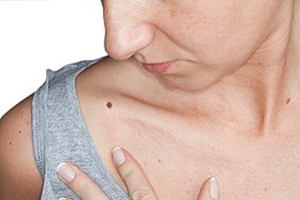
Skin Cancer
There are three main types of skin cancer that are usually caused by overexposure to UV radiation from the sun or tanning beds:
- Basal cell carcinoma
- Squamous cell carcinoma
- Melanoma
Basal cell carcinoma is the most common form of skin cancer. According to the Skin Cancer Foundation, an estimated 2.8 million people in the United States are diagnosed with this form every year. The second most common form is squamous cell carcinoma. Both basal cell and squamous cell carcinomas are highly treatable with conventional techniques and simple dermatologist treatments. The key is early diagnosis.
We believe a BODY CHECK or TOTAL SKIN EXAMINATION is essential for every individual from the age of 20, and in younger individuals if there is risk. In this check, our responsibilities are threefold; first to identify any suspicious lesions, second is to educate the patient with regard to their own skin; effectively customizing the skin exam, third to give the patient an understanding of the frequency of skin exams needed based on skin type and risk.
Symptoms of Skin Cancer
You should be aware of the skin on your entire body, face, hands, feet and scalp so you can notice any skin changes. Skin cancer can show up anywhere. We encourage thorough monthly self-examinations from head to toe.
Basal Cell Carcinoma Symptoms
- Pink pearly papule – similar to a pimple
- Flat red rashy spot
- Pink scaly rashy patch
- “Sore” that doesn’t heal for more than a month
Squamous Cell Carcinoma Symptoms
- Hard, rough, red bump
- Flat, scaly or crusty lesion
- Pink crusty lesion
Melanoma
Although it is far less common, melanoma accounts for the majority of skin cancer deaths. Also caused by intense UV radiation, melanoma is a mutation that causes skin cells to multiply and form malignant tumors that look like moles.
Characteristics of Melanoma
- Asymmetrical moles that are black, brown, flesh-colored, pink/red, white or purple/blue
- Moles with irregularly-shaped edges
- Moles with different colors
- Large moles
- Moles that change shape, size or color
Treatment for Melanoma
Early diagnosis and treatment is absolutely critical to stop the cancer from spreading to other parts of the body. Regular skin checks by Dr. Holy can help identify early signs of melanoma as well as the type of melanoma and the stage of the disease so treatment can be administered:
- Complete surgical removal of the melanoma
- Chemotherapy for advanced stages
- Immunotherapy
- Medications
There are other forms of less common skin cancer that can be identified during skin checks. To arrange for a skin cancer check in Phoenix, Arizona, contact THE CENTER for Advanced Dermatology today to schedule an appointment with Dr. Holy.


